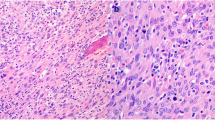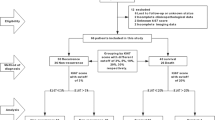Abstract
Adrenocortical tumors (ACT) in the adult and pediatric population are generally considered distinct entities due to differences in molecular events related to tumorigenesis, clinical presentation, and outcome. Furthermore, pathological criteria used for diagnosis and prognostication of ACT in adults are usually inadequate for predicting the biological behavior of ACT in children. Here, we analyzed 146 adult and 44 pediatric (< 15y/o) ACT with long-term clinical follow-up and furthered current evidence on the clinical and pathological differences between pediatric and adult tumors. Predilection for female over male gender was observed in both cohorts, but more so in adults (84% vs. 61%, p = 0.003). Cushing syndrome was more frequent in adults (p < 0.001), whereas virilization, either isolated (p < 0.001) or combined to Cushing (p = 0.047), was more common in children. The Ki67 labelling index (LI) of pediatric adenomas and carcinomas was much higher than their corresponding tumors in adults (p < 0.001). Despite these differences, pathological analyses including the evaluation of Ki67 greatly improved patient prognostication in both age cohorts. Indeed, increased Weiss scores and Ki67 indexes correlated with poor overall- and disease-free survival in adult patients with carcinoma. Among the proliferative indexes tested, Ki67 LI ≥ 10% showed the highest hazard ratio (HR) for recurrence and the Ki67 LI ≥ 3% showed the highest HR for survival. In pediatric tumors, the Wieneke score (p < 0.001) and the Ki67 LI (p < 0.001) showed high accuracy for predicting biological behavior, and increased scores/indexes correlated with worse overall and disease-free survival. In this age cohort, Ki67 LI < 10% was able to rule out malignant behavior, whereas Ki67 LI ≥ 15% may be used to predict the patients with higher risks of recurrence and/or poor outcome.


Similar content being viewed by others
References
Allolio B, Fassnacht M (2006) Adrenocortical Carcinoma: Clinical Update. J Clin Endocrinol Metab 91:2027–2037. https://doi.org/10.1210/jc.2005-2639
Else T, Kim AC, Sabolch A, Raymond VM, Kandathil A, Caoili EM, Jolly S, Miller BS, Giordano TJ, Hammer GD (2014) Adrenocortical Carcinoma. Endocr Rev 35:282–326. https://doi.org/10.1210/er.2013-1029
Custódio G, Komechen H, Figueiredo FRO, Fachin ND, Pianovski MAD, Figueiredo BC (2012) Molecular epidemiology of adrenocortical tumors in southern Brazil. Mol Cell Endocrinol 351:44–51. https://doi.org/10.1016/j.mce.2011.10.019
Ribeiro RC, Pinto EM, Zambetti GP, Rodriguez-Galindo C (2012) The International Pediatric Adrenocortical Tumor Registry initiative: Contributions to clinical, biological, and treatment advances in pediatric adrenocortical tumors. Mol Cell Endocrinol 351:37–43. https://doi.org/10.1016/j.mce.2011.10.015
Lalli E, Figueiredo BC (2015) Pediatric Adrenocortical Tumors: What They Can Tell Us on Adrenal Development and Comparison with Adult Adrenal Tumors. Front Endocrinol. https://doi.org/10.3389/fendo.2015.00023
Faria AM, Almeida MQ (2012) Differences in the molecular mechanisms of adrenocortical tumorigenesis between children and adults. Mol Cell Endocrinol 351:52–57. https://doi.org/10.1016/j.mce.2011.09.040
Pinto EM, Chen X, Easton J, Finkelstein D, Liu Z, Pounds S, Rodriguez-Galindo C, Lund TC, Mardis ER, Wilson RK, Boggs K, Yergeau D, Cheng J, Mulder HL, Manne J, Jenkins J, Mastellaro MJ, Figueiredo BC, Dyer MA, Pappo A, Zhang J, Downing JR, Ribeiro RC, Zambetti GP (2015) Genomic landscape of paediatric adrenocortical tumours. Nat Commun 6:1–10. https://doi.org/10.1038/ncomms7302
Michalkiewicz E, Sandrini R, Figueiredo B, Miranda ECM, Caran E, Oliveira-Filho AG, Marques R, Pianovski MAD, Lacerda L, Cristofani LM, Jenkins J, Rodriguez-Galindo C, Ribeiro RC (2004) Clinical and Outcome Characteristics of Children With Adrenocortical Tumors: A Report From the International Pediatric Adrenocortical Tumor Registry. J Clin Oncol 22:838–845. https://doi.org/10.1200/JCO.2004.08.085
Wang S, Chen S-S, Gao W-C, Bai L, Luo L, Zheng X-G, Luo Y (2017) Prognostic Factors of Adrenocortical Carcinoma: An Analysis of the Surveillance Epidemiology and End Results (SEER) Database. Asian Pac J Cancer Prev APJCP 18:2817–2823. https://doi.org/10.22034/APJCP.2017.18.10.2817
McAteer JP, Huaco JA, Gow KW (2013) Predictors of survival in pediatric adrenocortical carcinoma: A Surveillance, Epidemiology, and End Results (SEER) program study. J Pediatr Surg 48:1025–1031. https://doi.org/10.1016/j.jpedsurg.2013.02.017
Cagle PT, Hough AJ, Jeffrey TP, Page DL, Johnson EH, Kirkland RT, Holcombe JH, Hawkins EP (1986) Comparison of adrenal cortical tumors in children and adults. Cancer 57:2235–2237. https://doi.org/10.1002/1097-0142(19860601)57:11<2235::AID-CNCR2820571127>3.0.CO;2-O
Gupta N, Rivera M, Novotny P, Rodriguez V, Bancos I, Lteif A (2018) Adrenocortical Carcinoma in Children: A Clinicopathological Analysis of 41 Patients at the Mayo Clinic from 1950 to 2017. Horm Res Paediatr 90:8–18. https://doi.org/10.1159/000488855
Dehner LP, Hill DA (2009) Adrenal Cortical Neoplasms in Children: Why So Many Carcinomas and Yet So Many Survivors? Pediatr Dev Pathol 12:284–291. https://doi.org/10.2350/08-06-0489.1
Fassnacht M, Dekkers OM, Else T, Baudin E, Berruti A, Krijger RR de, Haak HR, Mihai R, Assie G, Terzolo M (2018) European Society of Endocrinology Clinical Practice Guidelines on the management of adrenocortical carcinoma in adults, in collaboration with the European Network for the Study of Adrenal Tumors. Eur J Endocrinol 179:G1–G46. https://doi.org/10.1530/EJE-18-0608
Strosberg JR, Hammer GD, Doherty GM (2009) Management of Adrenocortical Carcinoma. J Natl Compr Canc Netw 7:752–759. https://doi.org/10.6004/jnccn.2009.0051
Weiss LM (1984) Comparative histologic study of 43 metastasizing and nonmetastasizing adrenocortical tumors. Am J Surg Pathol 8:163–169
Aubert S, Wacrenier A, Leroy X, Devos P, Carnaille B, Proye C, Wemeau JL, Lecomte-Houcke M, Leteurtre E (2002) Weiss system revisited: a clinicopathologic and immunohistochemical study of 49 adrenocortical tumors. Am J Surg Pathol 26:1612–1619
Beuschlein F, Weigel J, Saeger W, Kroiss M, Wild V, Daffara F, Libé R, Ardito A, Al Ghuzlan A, Quinkler M, Oßwald A, Ronchi CL, de Krijger R, Feelders RA, Waldmann J, Willenberg HS, Deutschbein T, Stell A, Reincke M, Papotti M, Baudin E, Tissier F, Haak HR, Loli P, Terzolo M, Allolio B, Müller H-H, Fassnacht M (2015) Major Prognostic Role of Ki67 in Localized Adrenocortical Carcinoma After Complete Resection. J Clin Endocrinol Metab 100:841–849. https://doi.org/10.1210/jc.2014-3182
Sakoda A, Mushtaq I, Levitt G, Sebire NJ (2014) Clinical and histopathological features of adrenocortical neoplasms in children: Retrospective review from a single specialist center. J Pediatr Surg 49:410–415. https://doi.org/10.1016/j.jpedsurg.2013.09.008
Flynt KA, Dillman JR, Davenport MS, Smith EA, Else T, Strouse PJ, Caoili EM (2015) Pediatric adrenocortical neoplasms: can imaging reliably discriminate adenomas from carcinomas? Pediatr Radiol 45:1160–1168. https://doi.org/10.1007/s00247-015-3308-x
Wieneke J, Thompson L, Heffess C (2003) Adrenal Cortical Neoplasms in the Pediatric Population: A Clinicopathologic and Immunophenotypic Analysis of 83 Patients. Am J Surg Pathol 27:867–881
Picard C, Orbach D, Carton M, Brugieres L, Renaudin K, Aubert S, Berrebi D, Galmiche L, Dujardin F, Leblond P, Thomas-Teinturier C, Dijoud F (2019) Revisiting the role of the pathological grading in pediatric adrenal cortical tumors: results from a national cohort study with pathological review. Mod Pathol 32:546–559. https://doi.org/10.1038/s41379-018-0174-8
Das S, Sengupta M, Islam N, Roy P, Datta C, Mishra PK, Banerjee S, Chaudhuri MK, Chatterjee U (2016) Weineke criteria, Ki-67 index and p53 status to study pediatric adrenocortical tumors: Is there a correlation? J Pediatr Surg 51:1795–1800. https://doi.org/10.1016/j.jpedsurg.2016.07.014
Faria AM, Sbiera S, Ribeiro TC, Soares IC, Mariani BMP, Freire DS, Sousa GRV de, Lerario AM, Ronchi CL, Deutschbein T, Wakamatsu A, Alves VAF, Zerbini MCN, Mendonca BB, Fragoso MCBV, Latronico AC, Fassnacht M, Almeida MQ (2015) Expression of LIN28 and its regulatory microRNAs in adult adrenocortical cancer. Clin Endocrinol (Oxf) 82:481–488. https://doi.org/10.1111/cen.12607
Austin PC (2009) Using the Standardized Difference to Compare the Prevalence of a Binary Variable Between Two Groups in Observational Research. Commun Stat - Simul Comput 38:1228–1234. https://doi.org/10.1080/03610910902859574
Liang J, Liu Z, Zhou L, Tang Y, Zhou C, Wu K, Zhang F, Zhang F, Wei X, Lu Y, Zhu Y (2019) The clinical utility of ‘GRAS’ parameters in stage I–III adrenocortical carcinomas: long-term data from a high-volume institution. Endocrine. https://doi.org/10.1007/s12020-019-02141-2
Stojadinovic A, Brennan MF, Hoos A, Omeroglu A, Leung DHY, Dudas ME, Nissan A, Cordon-Cardo C, Ghossein RA (2003) Adrenocortical Adenoma and Carcinoma: Histopathological and Molecular Comparative Analysis. Mod Pathol 16:742–751. https://doi.org/10.1097/01.MP.0000081730.72305.81
Hanahan D, Weinberg RA (2011) Hallmarks of Cancer: The Next Generation. Cell 144:646–674. https://doi.org/10.1016/j.cell.2011.02.013
Author information
Authors and Affiliations
Corresponding author
Ethics declarations
Conflicts of Interest
The authors declare no conflict of interest.
Additional information
Publisher’s Note
Springer Nature remains neutral with regard to jurisdictional claims in published maps and institutional affiliations.
Rights and permissions
About this article
Cite this article
Martins-Filho, S.N., Almeida, M.Q., Soares, I. et al. Clinical Impact of Pathological Features Including the Ki-67 Labeling Index on Diagnosis and Prognosis of Adult and Pediatric Adrenocortical Tumors. Endocr Pathol 32, 288–300 (2021). https://doi.org/10.1007/s12022-020-09654-x
Accepted:
Published:
Issue Date:
DOI: https://doi.org/10.1007/s12022-020-09654-x




